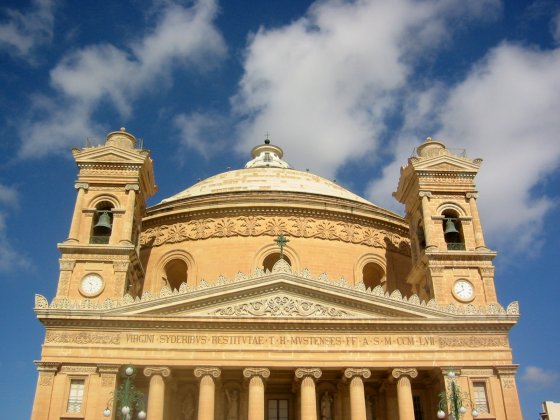David's Diary: Wednesday, October 16, 2002
Exploring Malta

Mosta Parish Church of St Mary (Mosta Dome)
We have been in Malta for ten days, but we have been so busy doing school and stocking up on food and boat supplies for the winter that we have not had much time to explore Malta, other than Valletta and some of the area near the boat. Today, we rented a car so that we can travel and see more of Malta.
We stop at a department store for some clothes for the children then continue along the road to Mosta. As Malta's population has increased, villages have grown together until today it appears at times to be one continuous urban sprawl. For the Maltese, each of these villages has its own unique character and identity. Mosta is far enough away that we do pass some green space before heading along a narrow one-way road into the center of town.

Mosta Dome
Our goal is the Mosta Dome or as it is formally known The Parish Church of St. Mary. Designed and built between 1833 and 1860 its circular design was based on the Pantheon. Only the Pantheon (43m) and St Peter's (42.1m) in Rome exceed Mosta Domes diameter of 39.6m.

WW II Bomb that struck the Mosta Dome
During WW II, three bombs landed on the dome. Two bounced off and landed in the square outside, but they did not explode. At the time 300 parishioners were inside waiting to hear Mass. The third bomb pierced the dome, hit the wall, and rolled across the floor without exploding. We visited a room in the back of the church where we looked at a bomb identical to the three that landed on the dome in WW II. For good reason that event is known as the Mosta Miracle.

Mdina Main Gate
There are so many roads on Malta that we find it easy to get lost and it takes a few wrong turns before we arrive at the hillside town of Mdina. The Phoenicians are believed to have built the first walls of the fortified citadel around 1000BC. The present name was given when the Arabs occupied Malta in the 9C -- madina is Arabic for "walled city".

Views from Mdina
We stopped for lunch inside the imposing walls. Then it was time to walk around the narrow streets. On the northeast side of the town we looked over the walls. Across the plains we could clearly see Mosta Dome and beyond that the Mediterranean. We continued on our walking tour, visiting the cathedral, then passing by the Nunnery of St Benedict. The members live in strict seclusion and no man is permitted to enter the convent. We did notice that windows lined the high walls that look down over the narrow street where we are walking. Perhaps the nuns are sometimes allowed to look at people outside their nunnery.

Stones of Hagar Qim
We left Mdina and drove across the island of Malta to Hagar Qim. Once again we got partly lost and ended up on potholed and narrow roads until we found a slightly better road to take us the last half of the distance. There are no real highways on Malta; it's just too small for that.
Hagar Qim is a megalithic temple and is the best preserved of Malta's prehistoric sites. The ancient stones predate Stonehenge, but the site is considerable smaller than the better-known one in England.

Internal Window
We strolled through the temples looking at the oval chambers inside. The temples would have originally been roofed over in wood, but those rotted away centuries ago. We wonder how people would have lived and communicated through the small windows between temples. It is wonderful to think that something can survive for so long. After a final stop to look out over the cliffs leading down to the Mediterranean, we returned to the car and found our way back to Dragonsinger.